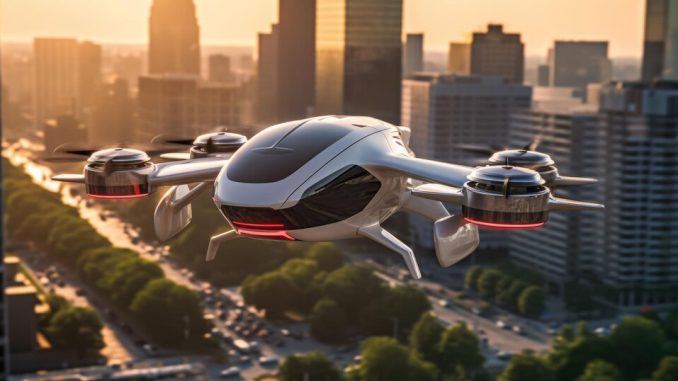
The future of transportation has long been represented by flying automobiles, sparking visions of flying above traffic. Technology has made these goals more possible than ever. Personal vehicles taking flight have fascinated humans for decades, appearing in science fiction and early aviation experiments. Flying cars seem promising as we prepare for the next transportation revolution. Tomorrow’s urban mobility may involve sky transport, redefining the urban commute.
Historical Perspective
The history of flying automobiles is fascinating, full of ingenuity, imaginative aspirations, and human resolve. Flying cars have been around for almost a century, but they acquired popularity in the early 20th century. Glenn Curtiss and Henry Ford experimented with road-air travel. Curtiss’ 1917 Autoplane was a roadable aircraft, while Ford’s “sky flivver” sought to popularize aviation. Early prototypes needed to be more robust but established the basis for innovation.
Mid-20th-century science fiction and movies reinforced flying automobiles as the future. We were inspired by “The Jetsons” and “Back to the Future”‘s DeLorean time machine. The 20th century saw several flying automobile ideas, from practical ones like the Taylor Aerocar to more creative ones. Despite obstacles, the concept of personal airborne mobility survived, laying the foundation for today’s flying vehicle chase.
Advancements In Technology
As technology advances, flying automobiles are becoming a reality. These astounding technical advances cover crucial areas needed to construct flying vehicles. One of the most significant advances is propulsion. Flying cars need electric vertical takeoff and landing (eVTOL) technology, which combines electric power with vertical flight. This method might revolutionize urban air travel with quieter, greener getaways.
Automation is also crucial to advancement. Flying vehicles are safe and efficient because of advanced avionics and autonomous flight control. These devices simplify piloting, making personal aerial transportation more accessible. Additionally, materials science and aerodynamics have improved. Aerodynamic design improves flying efficiency and stability, while lightweight, high-strength materials improve vehicle performance. These advances bring flying automobiles closer to reality, stretching the limitations of future fiction.
Urban Transportation Challenges
Modern cities have several transportation issues that affect people. Urban congestion causes lost productivity, stress, and more significant emissions. Traffic delays hurt cities’ economies and environments. Air pollution is another major issue. As car traffic rises, so do pollutant emissions, endangering urban residents and contributing to climate change. Global action is needed to address these issues.
Traditional road transport systems cannot expand due to infrastructural constraints. Innovative ways to lessen congestion, environmental effects, and urban inhabitants’ quality of life are needed. Flying automobiles might alter the game in this situation. These airborne vehicles might reduce traffic and provide an alternate means of travel. Flying cars can solve these urban transportation issues and establish more sustainable and efficient mobility systems.
Benefits Of Flying Cars
Flying vehicles may improve urban mobility and transit. five major benefits:
1. Reduced Traffic Congestion:
Flying vehicles reduce ground-based traffic congestion immediately. These aerial vehicles can avoid traffic and roadways, making them quicker and more efficient. This may save commuter commuting time, boost productivity, and minimize stress.
2. Environmental Sustainability:
Many flying vehicle prototypes employ electric or hybrid power. This eco-friendly technology reduces pollutants, making urban air travel more sustainable than automobile travel. Flying automobiles mitigates urban air pollution and climate change.
3. Emergency Response And Disaster Relief:
Flying automobiles are helpful in emergencies. They can quickly reach disaster-stricken or isolated places that are hard to get. Flying ambulances might save lives in emergencies.
4. Time Efficiency:
Flying vehicles make lengthy trips shorter and more efficient. Urban dwellers’ work-life balance, recreational possibilities, and quality of life may improve with this time-saving advantage.
5. Reduced Infrastructure Pressure:
Growing urbanization put a strain on ground-based transportation infrastructure. Flying vehicles may reduce this burden by adding a new transportation dimension. This may cut road expansions and infrastructure costs, freeing up funds for urban growth.
Regulatory And Safety Considerations
Flying vehicles are thrilling, but they raise regulatory and safety concerns. Integrating flying automobiles into urban airspace takes a lot of work. It requires sophisticated regulatory structures to assure sky safety, efficiency, and order. To maximize this developing technology’s advantages, innovation and security must be balanced. To make flying vehicles safe and successful in urban areas, industry players, lawmakers, and regulators must plan and coordinate.
Future Possibilities
Flying automobiles have transformational potential. As technology evolves and these cars become more common, they might change urban travel in several ways. Some interesting future possibilities:
1. Reduced Urban Congestion:
City traffic congestion may be solved by flying automobiles. These vehicles may avoid ground traffic and go faster by flying. This may minimize traffic and improve urban accessibility.
2. Urban Planning And Infrastructure Changes:
Flying vehicles in urban transportation networks may need urban design adjustments. Cities might establish aviation corridors and landing zones. This city infrastructure redesign may improve green areas, reduce road infrastructure, and boost urban design flexibility.
3. Improved Accessibility:
Flying automobiles can reach isolated locations. This might boost tourism, economic growth, and urbanization. Rural regions should be better linked to cities.
4. Emergency Response:
Emergency response and disaster assistance may benefit from flying automobiles. More efficient medical evacuations, firefighting, and search and rescue operations may save lives in critical circumstances.
5. Personalized Transportation:
Flying vehicles may provide tailored point-to-point transportation. this might transform city travel by making it more convenient, efficient, and personalized.
Flying vehicles have immense potential, but regulatory, safety, and infrastructural issues must be addressed. To maximize advantages, these issues must be addressed. Tomorrow’s urban mobility will fly, opening new transit and city planning possibilities.
Conclusion
Flying vehicles offer an exciting urban transportation future. The idea of flying for everyday journeys becomes more realistic as technology and regulations evolve. Flying cars can change our cities and lifestyles despite their limitations. Flying vehicles might solve some of the most significant urban transportation issues in the future.






Leave a Reply